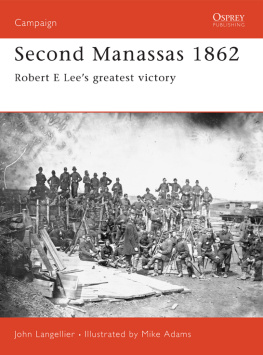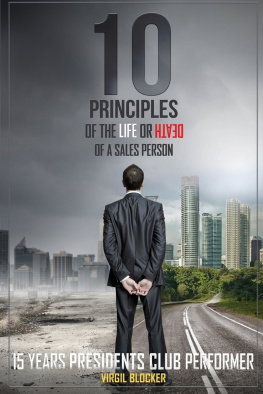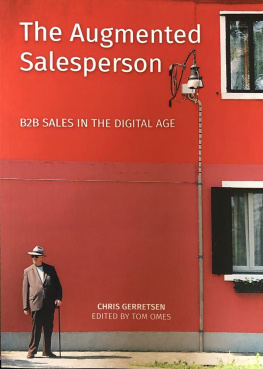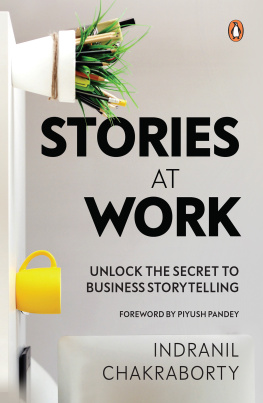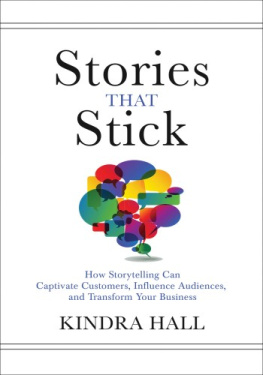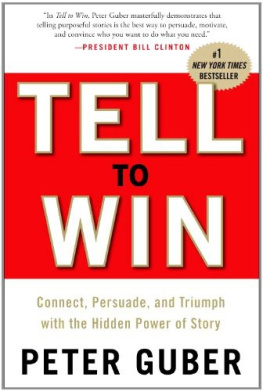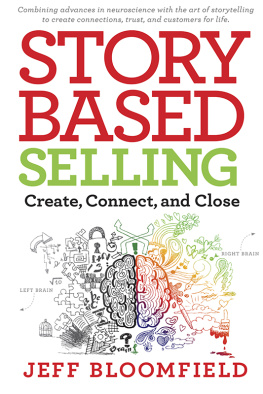www.mysevenstories.com
Mike Adams Seven Stories Every Salesperson Must Tell is a brilliant handbook on storytelling for sales professionals that delivers the key elements missing in other works to make this highest form of selling both intuitive and actionable. Highly recommended!
James Muir. CEO Best Practice International
and author of The Perfect Close
Finally a book that calls out storytelling for its relevance, power and potential in the business world. Mikes honesty and expertise in nailing and teaching the finer points of the perfect story is a great guide for all levels of sales professional to hone and adapt their storytelling skills to gain relevance, credibility and significant business outcomes, as well as build better connections with customers and stakeholderswhen you listen to anothers story carefully, with an open heart, the truth of the character shines through.
Cheryl Robertson. State Director WA, Microsoft Australia
Mike Adams has written a timelessly brilliant book for everyone who seeks to lead, influence or sell. He makes the profoundly simple point that Youll sell more and youll sell better when you tell and share purposeful stories. Mike has real-world experience and has himself sold more than $1 billion of business. Selling is one of toughest professions and Mike explains exactly how business storytelling is the master key that unlocks all stages of the buying and selling cycle. Masterful storytelling is how to get to the next level of influence and success. I highly recommend this book for anyone in leadership or sales, regardless of their level of experience.
Tony Hughes. CEO RSVP Selling and author of
The Joshua Principle and Combo Prospecting
Of the thousands of sales books written every year only a few stand out as ground-breaking only a few will stand the test of time. Mike Adams book Seven Stories Every Salesperson Must Tell is one of those.
As the title suggests it is peppered with compelling true stories that reinforce why storytelling is an essential sales skill and why we need to prepare and practise our seven stories. And most importantly, Mike tells us how. He provides a very clear and structured approach to creating, practising and delivering our stories, each at the appropriate time in the buying journey and sales process.
This book is an outstanding read and the best sales storytelling book I have read.
John Smibert. Founder Sales Masterminds APAC
and CEO Custell Strategic Selling Group
A highly practical and engaging guide to how storytelling can create both positive customer experience AND a competitive advantage in any crowded market. We all know storytelling works. Mike has provided the best guide to how to make it work Ive seen in 30 years of sales globally.
Dean Mannix. CEO SalesROI and SalesITV
The ability of a salesperson to tell stories is extremely powerful. Mike Adams does an excellent job of providing a framework to lead sellers to success. He discusses the key elements of stories and the importance of sharing these with prospects, rather than boring case studies and bullet points. The bottom line: stories work! Adams shows how persuasive they can be when done right.
Mike Shulz. President of RAIN Group and co-author of Insight Selling
First published in 2018 by Mike Adams
Mike Adams 2018
The moral rights of the author have been asserted
ISBN: 978-1-9256487-0-6
All rights reserved. Except as permitted under the Australian Copyright Act 1968 (for example, a fair dealing for the purposes of study, research, criticism or review), no part of this book may be reproduced, stored in a retrieval system, communicated or transmitted in any form or by any means without prior written permission. All inquiries should be made to the author.
A catalogue entry for this book is available from the National Library of Australia.
Project management and text design by Michael Hanrahan Publishing Cover design by Peter Reardon
All images used with permission. Image credits:
Front cover image: Crayon and pencil sketch by Megan Adams, from a photograph by Craig Moore from The English Fly Fishing Shop (www.flyfishing-flies.com)
Modified fly image part 1: Photo by Michael Svoboda, Getty Images, ID 164587281
Modified brain image chapter 1: Artist Alexandr Mitiuc, Dreamstime, ID 18894695
Modified fishing image part 2: Fly fishing trout fisherman, Getty Images, ID 458253697
Modified fish image part 3: Rapids Camp 136 by Abe Blair Photography
Modified fish image part 4: Trout in net: Image Barry Garner, Dreamstime, ID 45166961
Author photo: Peter Singer
Disclaimer
The material in this publication is of the nature of general comment only, and does not represent professional advice. It is not intended to provide specific guidance for particular circumstances and it should not be relied on as the basis for any decision to take action or not take action on any matter which it covers. Readers should obtain professional advice where appropriate, before making any such decision. To the maximum extent permitted by law, the author and publisher disclaim all responsibility and liability to any person, arising directly or indirectly from any person taking or not taking action based on the information in this publication.
Contents
Foreword
by Mike Bosworth
Reading Mike Adams Seven Stories has caused me once again to reflect on how I think about sales effectiveness.
My sales journey began in 1972, working for Xerox Computer Services (XCS) which was founded in 1969 by the great James S. Campbell. Most people know Xerox invented more technology that they never made money on than any other tech organisation. Desktop icons, the mouse, Ethernet, the list goes on. Most people dont know that Xerox Computer Services also invented cloud computing.
When I joined XCS in 1972 after serving in the military and graduating from Cal Poly, Pomona, we had 50 Los Angeles based customers communicating real-time transactions over dumb terminals in departments like cost accounting, fund accounting, payroll, production control and material control. In case you think Software as a Service is a new thing, our customers paid us for the usage of our applications, for storage on our disk drives, for reports by the print line and for transactions (every enter was 2.2 cents). If the customers didnt use our system, there was no revenue. Because of this revenue model, all XCS employees were focused on keeping those 50 customers online.
I went through the same six weeks of product demo school that our newly hired, experienced salespeople (mostly ex-IBM) went through. At the end of product school they went into sales. But I was hired to do the job nobody else wanted help desk support. I was just 25.
It typically took those experienced former IBM salespeople between nine and fifteen months to make their first sale. My 20/20 hindsight tells me that it took them that long to figure out how the job titles we were calling on could use our product. Demo school did not teach product usage by job title.
Xerox was also ahead of its time in the way they on-boarded me. I was employee number 120, and within two months of joining, my wife and I were invited to dinner with senior managers and executives from sales, marketing, operations, finance and product development. During these dinners we shared stories about our individual paths to where we were now working. Through those interactions I formed an emotional connection with the heads of multiple departments. If I had an unhappy customer on the phone, I knew who to call.


